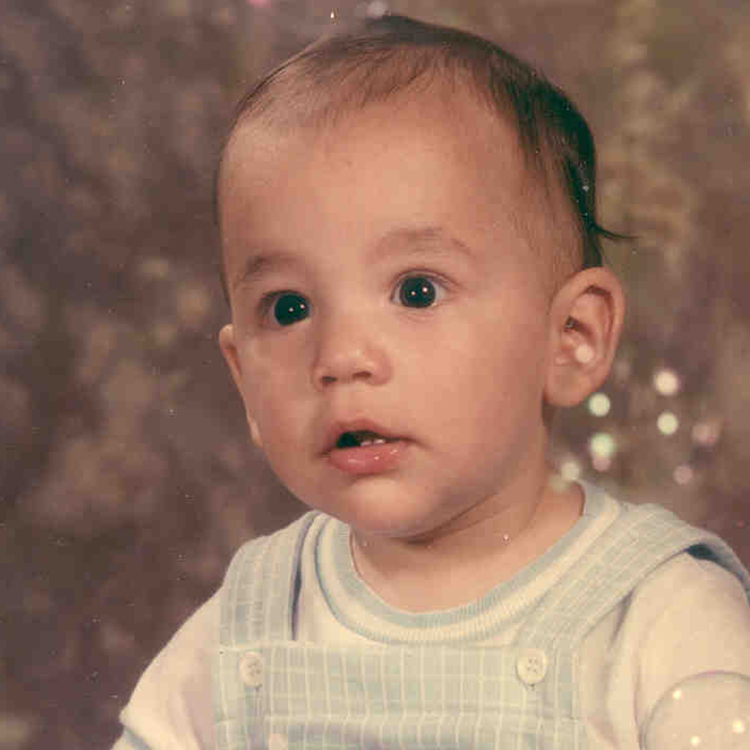Family Voices — Danny Lineweaver’s Story
Danny Lineweaver was strangled when his clothing caught on the corner post of his crib. He was almost 2 years old.

Submitted by his parents, John and Rose
On July 14, 1984, just shy of his second birthday, Danny was put down for a nap in his Alamo, California home. When his mother went to check on him, she found him hanging outside his crib by his shirt, which had become entangled on the corner post extension of his crib. Danny had been strangled and suffered permanent brain damage and severe physical disabilities. Danny’s doctors doubted he would live through the end of the year but after 9 years of loving care at home Danny died on October 3, 1993, at age eleven, from complications of a respiratory illness. The youngest of 12 children, Danny was described in a eulogy by family friend as “the absolute center of attention in that household—the center of an enormous circle of love and affection in this large family of truly exceptional people.”
Danny’s parents assumed their son had been the victim of a ‘freak accident’, but soon learned that 40 children had died in similar circumstances over the past 10 years. Danny was the 21st child to known to suffer this exact type of crib accident in the 13 years that the Federal Government had been keeping statistics. The Lineweavers discovered that cribs—the only juvenile product manufactured for the explicit purpose of leaving a child unattended—caused approximately 100 deaths each year. And as they knew too well, this horrifying statistic did not include those kids like Danny who had survived only to live restricted and dependent lives. Yet nothing was being done to prevent the same tragic accident from happening again and again.
What’s happened since Danny’s death?
Danny’s parents turned their grief into positive action. They created the Danny Foundation in 1986 with the mission to educate the public about the dangers associated with cribs and advocate to rid the market of these unsafe products. In its nearly twenty years in operation, the Foundation worked to develop regulatory standards for safe nursery products and petition CPSC to recall unsafe cribs. As a result of the Foundation’s efforts, California became the first state to pass a law making it illegal to use cribs not meeting current safety standards for any commercial purposes.
Crib recalls began to rise in 2005. Since 2007, over 9 million cribs have been recalled.
A new federal safety standard went into effect on June 28th, 2011. All cribs manufactured after that date must comply with 5 new standards, and cribs manufactured before June 28th, 2011 should not be bought, sold, or used. See the CPSC website for more information.
How You Can Take Action
To take action and help prevent further incidents, injuries, and deaths,
there are a number of things you can do:
- Follow the ABCs of safe sleep at every sleep time: 1) Baby is Alone and has their own separate sleep space. 2) Baby is placed to sleep on their Back, and 3) baby sleeps in a Crib, play yard or bassinet that meets the federal safety standard.
- Remove other products such as crib bumper pads, pillows, positioners, extra padding, blankets, stuffed animals, or toys from the sleep environment.
- Share KID’s safe sleep PSA.
- Report any incidents to the CPSC at SaferProducts.gov.
- Read more about crib safety here, on our page dedicated to Danny Lineweaver’s legacy.
Check out our action steps for all children’s products here.
More Information on Cribs
Although mandatory standards exist for cribs, only recently has an effort been made to strengthen those standards and require testing and verification of new cribs. Because of these standards, all cribs must include proper assembly instructions and diagrams as well as cautionary and warning labels as required by federal law.
More information on Safe Sleep
A safe sleep environment is the one place parents and caregivers can place an infant and know they will be safe, even as the parent sleeps or attends to other things. Infants sleep safest following the ABC’s of safe sleep—Alone, on their Back and in a Crib, bassinet or play yard that meets federal standards and hasn’t been recalled. AAP also recommends babies sleep on a flat surface and unrestrained. Nothing should be in the crib except a firm mattress with a tight-fitting sheet.
View our safe sleep video to learn more about how to keep your baby safe while sleeping.
